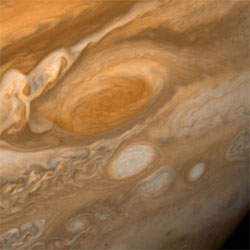Big Waves from a Small Source
The atmospheres of giant planets feature alternating eastward- and westward-flowing bands. In the 24 October Physical Review Letters, researchers use computer simulations to analyze how small-scale fluctuations sustain this flow. The fluctuations lead to a previously unknown type of persistent eddy-like structure that the researchers cannot yet fully characterize. But the mysterious structure could be an important feature of planetary atmospheres–or of the Earth’s oceans.
The rotation of a planet leads to the colored bands of oppositely moving gas that are visible on Jupiter and Saturn. These “zonal jets” appear even in models that approximate the atmosphere as a two-dimensional spherical shell. Recent satellite observations suggest that similar jets may also occur in the oceans on Earth.
However, the average flow is only the beginning of the story. One standard feature of planetary atmospheres is Rossby waves, exemplified by the undulations of Earth’s jet stream as it wanders north or south. To explore the interaction of these waves with each other and with the zonal jets in a turbulent environment, Boris Galperin of the University of South Florida in St. Petersburg and his collaborators at Ben-Gurion University of the Negev in Israel have been numerically studying the turbulent flow in a two-dimensional model.
In the familiar, three-dimensional turbulence of a plume of smoke or a stream of water, an initially large, smooth whorl breaks up into ever smaller whorls, until the smallest structures eventually break up, with their energy becoming heat. “Normally energy goes to small scales,” says Galperin. But in a two-dimensional shell, turbulence exhibits an “inverse” cascade, in which energy moves to successively larger scales. The tiniest whirlpools merge into ever larger ones, so that the largest-scale structures–such as zonal jets and Rossby waves–are essentially powered by energy that comes from the smallest ones.
To explore this process, the researchers modeled energy injected on small length scales, such as might be caused by local variations in pressure or temperature in the planetary environment. Their model included a sort of “background noise” of small fluctuations to simulate these many small-scale sources of energy for the fluid flow. Then they looked at the large-scale motions in which the energy eventually accumulates. In a certain range of conditions, “you see two different kinds of waves,” says Galperin–Rossby waves and another type that the team calls zonons. The zonons travel at the same speed as the Rossby waves but are long-lived, eddy-like motions. The team has not visualized them directly but has seen them in spectra of velocity fluctuations as additional peaks at certain length scales and frequencies. “They form westward propagating eddies,” says Galperin, “and we hope others will look for them in planetary observations.”
The results are important because these “resilient coherent structures haven’t been explored before,” says Peter Read of Oxford University in England. But he adds that “we still need some more work to understand what these coherent structures are and what their significance is.”
–Don Monroe
Don Monroe is a freelance science writer in Murray Hill, New Jersey.





